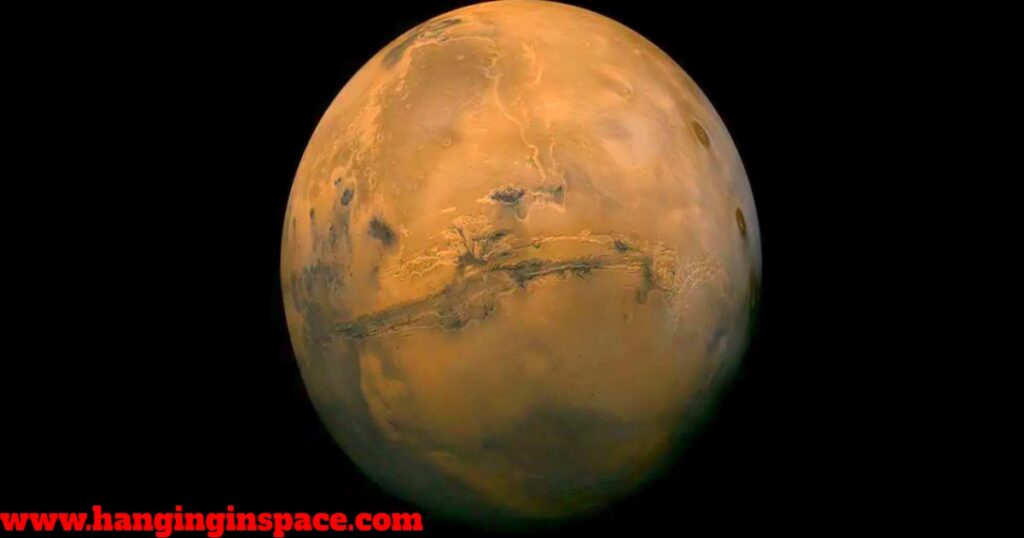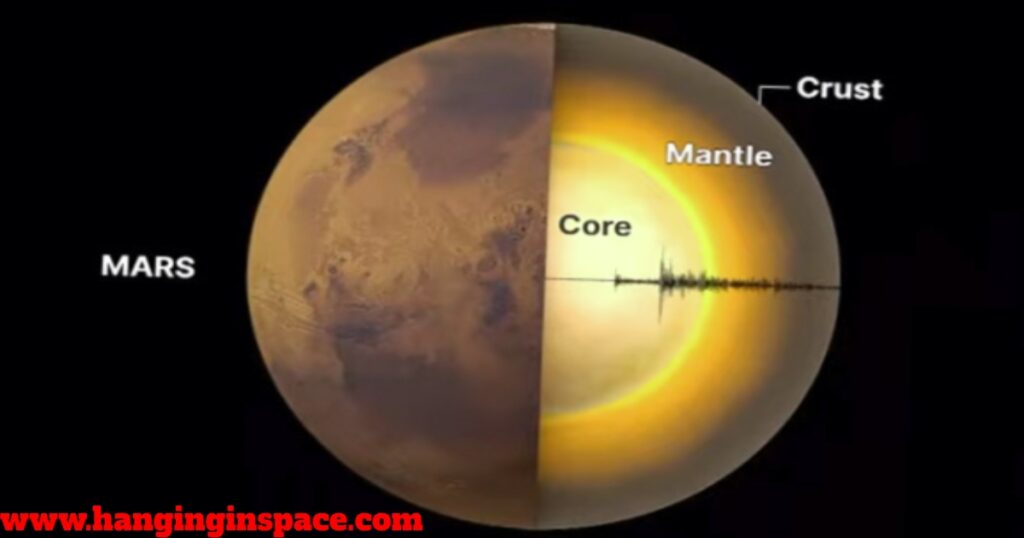Mars is known as the Red Planet because of its iron-rich dust. It is the fourth planet from the Sun and it’s Earth‘s nearest planetary neighbor. It’s a globe of volcanoes, canyons, and polar ice caps, indicating a watery past and the possibility of life.

What is the Size of Mars?
Mars’ radius is 3,389.5 kilometers (2,106.1 miles). Mars’ diameter is 6,779 kilometers (4,212.2 miles). Mars’ circumference is 21,343 kilometers (13,256.8 miles). This makes it about half the size of Earth and only slightly larger than Earth’s moon.
What is the Mass and Volume of Mars?
Mars has a mass of approximately 6.39 × 10^23 kilograms. Mars’ volume is approximately 1.6318 x 10^11 cubic kilometers (km^3).
What is the Temperature of Mars?
Mars has an average temperature of -63°C (-81°F). However, the temperature can swing dramatically depending on location and time of day. Near the equator at noon, temperatures can climb to a balmy 20°C (68°F), while at night or near the poles, it can plummet to a bone-chilling -153°C (-243°F). This vast difference highlights the weak insulating ability of Mars’ thin atmosphere.
What is Mars’ Average Distance from the Sun & Earth?
Mars’ average distance from the Sun is about 227.9 million kilometers, or roughly 1.52 astronomical units (AU). Mars’ average distance from Earth is approximately 225 million kilometers (140 million miles).
How long does it take Mars to Orbit the Sun?
It takes Mars approximately 687 Earth days to orbit the Sun. This is also known as Mars’s orbital period, which is significantly longer than Earth’s year (365.25 days).
How long does it take Mars to Spin on its Axis?
One full rotation on Mars takes approximately 24.6 hours, which is very close to a day here on Earth (24 hours).
Gravitational Field Strength:
The average gravitational acceleration on the surface of Mars is approximately 3.71 m/s² (meters per second squared). The gravity on Mars is about 38% of Earth’s gravity. This means an object that weighs 100 kg on Earth would only weigh about 38 kg on Mars.
Escape Velocity:
The escape velocity required to leave the gravitational pull of Mars is approximately 5.03 kilometers per second (km/s).
Moons of Mars:
Mars has two moons.
Phobos:
The larger of the two, Phobos is closer to Mars, orbiting the planet three times a day! This rapid orbit and its oddly shaped, potato-like form raise questions about its stability and future.
Deimos:
Smaller and farther out, Deimos takes a leisurely 30 hours to complete its orbit. Both moons are incredibly dark and dusty, with Phobos sporting a giant crater that dominates its surface.
What is the Composition of Mars?
Mars is a terrestrial planet with a rocky surface and a thin atmosphere. Mars’ reddish tint is attributable to iron oxide (rust) on its surface, which gives it a distinct appearance when viewed from Earth.
The Martian terrain is characterized by a variety of geological characteristics, including wide plains, towering volcanoes, steep gorges, and ancient riverbeds. The planet’s two most notable features are Olympus Mons, the solar system’s largest volcano, and Valles Marineris, a vast canyon system spanning 4,000 kilometers (2,500 miles) across the Martian equator.
What is the Interior Structure of Mars?
Mars’ interior structure consists of a core, mantel, and curst.
Mars’s Core:
Scientists estimate Mars’ core to have a radius of about 1,830 kilometers and be primarily composed of iron and sulfur. Mars’ core may be partially molten, allowing for movement and contributing to the planet’s weak magnetic field.
Mars’ Mantel:
This thick layer, extending for about 1,560 kilometers, is thought to be composed of silicate rock, similar to Earth’s mantle but potentially richer in elements like iron. This mantle is likely the source of the volcanic activity that once shaped the Martian surface.
Mar’s Curst:
The outermost layer, averaging around 50 kilometers thick with some variations, is rich in iron oxide (rust), giving Mars its characteristic red color. Basalt rock, similar to volcanic rock on Earth, is also a major component.

What does the Atmosphere of Mars consist of?
Mars, in contrast to Earth’s complex atmospheric layering, has a much simpler structure. Here’s a breakdown of the three main layers that make up the Martian atmosphere:
Troposphere:
This is the lowest and densest layer of the Martian atmosphere, accounting for about 95% of its total mass. Similar to Earth’s troposphere, it’s the region where most weather phenomena on Mars, like dust storms and thin clouds, occur.
Temperatures in the troposphere vary significantly depending on altitude and time of day. The average temperature near the surface is a frigid -63 degrees Celsius (-81 degrees Fahrenheit), though it can fluctuate considerably.
Mesosphere:
The middle layer of the Martian atmosphere, the mesosphere is the coldest region. Temperatures here can plummet to a bone-chilling -143 degrees Celsius (-225 degrees Fahrenheit).
This layer plays a crucial role in the absorption of solar radiation, which helps to heat the thermosphere above.
Exosphere:
The outermost and thinnest layer of the Martian atmosphere, the exosphere gradually merges with the emptiness of space. Molecules in this region have very high velocities and can escape the Martian gravity relatively easily.
The exosphere is significantly influenced by the solar wind, a stream of charged particles emanating from the Sun.
Mars boasts a thin atmosphere, primarily composed of carbon dioxide (CO2) with trace amounts of nitrogen and argon. This thin atmosphere makes Mars a frigid world.
What is Mars’ Magnetosphere?
Mars has a weak magnetic field that is believed to have faded over time. Its magnetosphere is much smaller than Earth’s, leaving the planet vulnerable to solar wind and radiation.
Mars’ Formation:
Mars formed approximately 4.6 billion years ago, during the early stages of the solar system’s formation. It is believed to have formed from the same primordial material as Earth and the other inner planets, known as terrestrial planets. Mars’ formation likely followed a similar process to that of Earth, involving the accumulation of dust and gas in the protoplanetary disk surrounding the young Sun.
Over time, gravitational interactions caused these particles to clump together, forming larger bodies known as planetesimals. These planetesimals eventually collided and merged to form Mars.
However, Mars’ formation differed from Earth’s in some key aspects. It is smaller and less massive than Earth, which may have resulted from less material being available in its region of the protoplanetary disk or from gravitational interactions with Jupiter, the largest planet in the solar system.
When and Who Discovered Mars?
Mars’ discovery dates back to ancient times, with observations by various civilizations such as the Egyptians, Greeks, and Chinese. However, the first recorded telescopic observation of Mars was made by Italian astronomer Galileo Galilei in 1610.
Over the following centuries, astronomers made detailed observations of Mars’ surface features and mapped its rotation period and axial tilt.
In the 19th century, improvements in telescopes and astronomical techniques allowed for more accurate observations of Mars, including the identification of its polar ice caps and dark surface features, which led to speculation about the possibility of life on the red planet.
Today, Mars continues to be a subject of fascination and exploration, with numerous robotic missions sent to study its surface and search for signs of past or present life.

Mars Exploration:
The era of space exploration brought new opportunities to study Mars up close, with numerous robotic missions launched to explore its surface and atmosphere.
The first successful flyby of Mars was achieved by NASA’s Mariner 4 spacecraft in 1965, followed by a series of successful orbiter and lander missions, including the Viking program in the 1970s and more recent missions such as the Mars rovers Spirit, Opportunity, and Curiosity.
One of the most recent missions is NASA‘s Perseverance rover, which landed on Mars’ Jezero Crater on February 18, 2021. Equipped with advanced scientific instruments and cutting-edge technology, Perseverance aims to search for signs of past microbial life, collect rock and soil samples for future return to Earth, and demonstrate technologies for future human Mars exploration.
Mars as compared to Jupiter:
Mars Vs. Jupiter
| Feature | Mars | Jupiter |
|---|---|---|
| Type | Terrestrial Planet | Gas Giant |
| Average Distance from the Sun (AU) | 1.52 | 5.20 |
| Diameter | 6,779 km | 143,880 km (11.2 times Earth’s diameter) |
| Volume | 1.63 x 10^11 km³ | 1.43 x 10^15 km³ (1,321 Earths) |
| Mass | 6.42 x 10^23 kg | 1.898 x 10^27 kg (317.8 times Earth’s mass) |
| Density | 3.93 g/cm³ | 1.33 g/cm³ (less dense due to gaseous composition) |
| Atmosphere | Thin atmosphere (primarily carbon dioxide with traces of nitrogen, argon, and others) | Thick atmosphere (primarily hydrogen and helium with trace amounts of methane, ammonia, water vapor, and others) |
| Surface Temperature | -63°C (average) | -145°C (average) |
| Surface | Solid surface with canyons, volcanoes, and polar ice caps | No true solid surface; atmosphere transitions smoothly into liquid and eventually gas as you go deeper |
| Internal Structure | Crust, Mantle, Core | Metallic hydrogen core, outer shell of liquid hydrogen and helium, surrounded by a thick atmosphere |
| Moons | 2 (Phobos and Deimos) | Numerous moons (79 confirmed, with many more likely) |
| Rings | No rings | Faint ring system composed of dust and debris |
Conclusion:
Mars, with its mysteries and potential for scientific discovery, remains one of the most intriguing destinations in the solar system. As exploration efforts continue to reveal new insights into the planet’s geology, climate, and potential for life, Mars continues to inspire humanity’s collective imagination.
